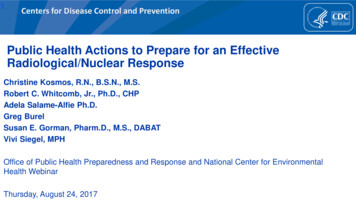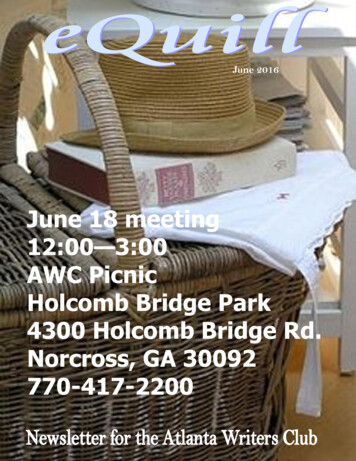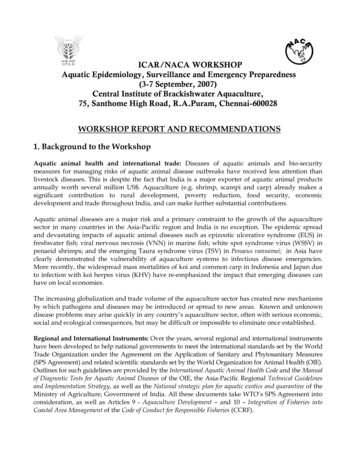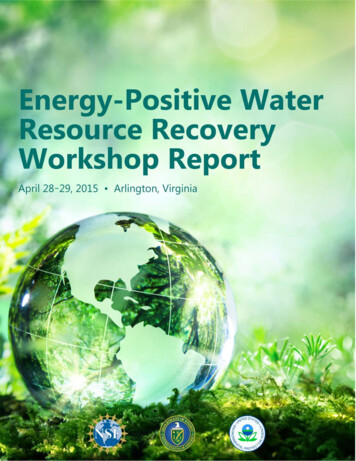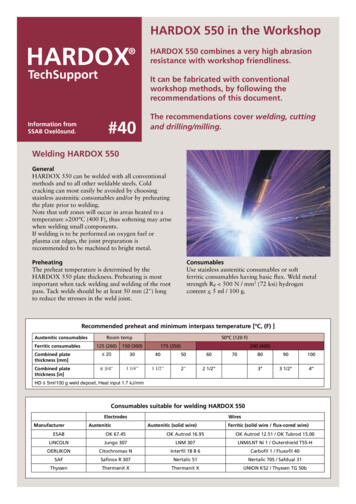
Transcription
AIAA 95-2599Report on the NASAIJPL Workshop onAdvanced Quantum/Relativity TheoryPropulsionGary L. Bennett, Metaspace Enterprises, Boise IDRobert L. Forward, Forward Unlimited, Malibu CARobert H. Frisbee, Jet Propulsion Laboratory,Pasadena CA31st AIAA/ASME/SAE/ASEEJoint Propulsion Conference and ExhibitJuly 10-12, 1995 I San Diego, CAFor permission to copy or republish, contact the American Institute of Aeronautics and Astronautics370 L'Enfant Promenade, S.W., Washington, D.C. 20024
Report on the NASA/JPL Workshop onAdvanced Quantum/Relativity Theory PropulsionGary L. Bennett11,Robert L. Forward2,and Robert H. Frisbee 3Metaspace Enterprises; 7517 West Devonwood Drive; Boise ID 837032 Forward Unlimited; P.O. Box 2783; Malibu CA 902653 Jet Propulsion Laboratory; 4800 Oak Grove Drive; Pasadena CA 91109ABSTRACTIn an effort to address the FTL question the Officeof Advanced Concepts and Technology (OACT) ofNASA Headquarters and the Jet PropulsionLaboratory (JPL) sponsored a workshop onadvanced quantum/relativity theory propulsion atJPL on 16-17 May 1994. Appendix 1 lists theattendees at the workshop.In May 1994, NASA and JPL sponsored aworkshop on advanced quantum/relativity theorypropulsion concepts to establish and use newframes of reference tor thinking about thetaster-than-light (FTL) question. Using the horizonmission methodology, the participants reviewedwormholes: a hypothetical physics where thespeed of light (c) is a lower bound; and the physicsof additional space dimensions.While theparticipants did not identity any obvious method toachieve FTL travel they did identity enough openissues in physics that FTL travel could not be ruledout.Moreover, several experiments wereidentified that could elucidate some possibleFTL-related phenomena.The first premise of the workshop was thattheoretical perspectives exist in advancedquantum and relativity theory that couldconceivably perm FTL travel or informationtransfer. A second premise was that investigationof these perspectives from other frames ofreference could possibly provide fresh insights.The purpose of the workshop was to establish anduse new frames of reference for thinking about theFTL problem. The objectives of the workshopwere to1. INTRODUCTIONContained within the paradigm of the human raceas a species genetically predisposed towardexploration is the view that eventually our specieswill expand beyond the Solar System. In order torealize interstellar civilizations in which the vastdistances between star systems must be spannedin times much less than the lifetimes of the crewand the people remaining on the planets, theremust be a revolution in transportation technology.However, the general opinion within the physicscommunity has been that the special theory ofrelativity precludes such short transit timesbecause they would involve taster-than-light (FTL)travel. 1 identify theoreticallypermitted"scientificwindows" that could permit FTL travel orinformation transfer; identify manifestations of the underlying physics; identity avenues of scientific and technologicalresearch to explore and validate the possibilities; define (where possible) enabling technologyconcepts tor FTL travel; and introduce the horizon mission methodology asa tool tor thinking in other frames of reference.Copyright 1995 by the American Institute ofAeronautics and Astronautics, Inc. No copyright isasserted in the United States under Title 17, U.S. Code.The U.S. Government has a royalty-free license toexercise all rights under the copyright claimed herein forGovernmental Purpcses. All other rights are reservedby the copyright owner.The critical reader should be aware that eventhough the special theory of relativity seems topresent insurmountable obstacles to FTL travel orcommunication (infinite energies, time travelparadoxes, etc.) there are at least thirteen '1hings"1American Institute of Aeronautics and Astronautics
that move faster than light 2.3.4highly productive" 8 As shown in Figure 1, the HMM is based oncreating a future frame of reference for evaluatinga topic.In the case of the advancedquantum/relativity theory propulsion workshop theinvited participants were asked to imagine thatthey were in the future where FTL travel orinformation transfer had been achieved and thento "look backward" to see how it wasaccomplished. In essence, are there theoreticallypermitted reinterpretations of physics or "scientificwindows" that could permit FTL travel?Scissor-blade intersectionSearchlight beam imageEclipse shadowPerfectly rigid rodGalloping wavesQuasar expansionPlasma phase velocityMarquee lightComet tailRiptideOscilloscope traceExpansion of spacetime"Practical speed" of a nearly-as-fast-as-lightspaceshipThese scientific windows could be expressed interms of new axioms or principles such asMore recently there have been a series ofexperiments showing either that light quanta cantunnel through barriers or that microwaves cantravel through the '1orbidden regions" of a waveguide at speeds greater than the speed of light,aHhough it is not certain that this technique allowssignals (in Einstein's sense of transmitting usefulinformation) to be sent. 5·6 Even Einstein wrote Cosmic (spacetime) tunnels exist and can beused. There exists an "entire physics" in which thespeed of light (c) is a /ower bound. Other, perhaps "higher" dimensions exist thatcan interact with the spacetime that we know.that ". our result shows that, according to thegeneral theory of relativity, the law of theconstancy of the velocity of light in vacuo, whichconstitutes one of the two fundamentalassumptions in the special theory of relativity andto which we have already frequently referred,cannot claim any unlimited validity. A curvature ofrays of light can only take place when the velocityof propagation of light varies with posftion". 7For each of these scientific windows backgroundinformation was provided by specialists in the fieldand then the participants discussed the particularscientific window using the horizon missionmethodology to "look backward" to see how thatparticular scientific window could have led to FTLtravel or communication.The following sections discuss these threescientific windows as they were covered in theworkshop.For each scientHic window, theparticipants were asked to consider the followingquestions:1.1 Horizon Mission MethodologyRecognizing that solving a problem in advancedmissions or technology by extrapolating from theconventional technology can create obstacles tobreakthrough solutions, John L. Anderson ofNASA Headquarters developed the horizonmission methodology (HMM). As Anderson haswritten, "The Horizon Mission Methodology is ahighly structured process for both creating andthinking within a new frame of reference. It is nota process of forecasting, scenario-generation orbrainstorming. It first poses a truly challenging,relevant space future that is beyond our reach.The process then places people mentally in that'fixed' future, which is treated as an accomplishedfact. Next it stimulates the imagination to generatebreakthrough-based aHernatives for accomplishingthat future and to reconstruct pathways that couldhave led to it. This process requires signHicantmental discipline to 'stay in character,' but it is What properties does it have?What is the evidence for/manifestation of?What are the alternative physics interpretations?What are the implications and manifestations ofthese aHernative interpretations? What avenues and approaches can be taken forvalidation? What are the potential technological concepts?1.2 ETL Horizon MissionsRobert H. Frisbee, who was the JPL host andorganizer of the workshop, followed the HMMdiscussion with an overview of the three principalscientific windows. He noted that any interstellarmission, whether conventional or FTL, will require2American Institute of Aeronautics and Astronautics
not even survive the trip to the horizon. Evenvariations on the classic static black hole presentproblems.A Schwarzschild (sphericallysymmetric) wormhole would pinch off into infinitetidal forces before anything could get through.The horizon of a black hole is a one-waymembrane, i.e., once inside nothing can get backout.For Kerr (rotating) black holes andReissner-Nordstrom (charged) tunnels, Morrisobserved that while they are mathematically exactthey are unrealistic with ring-shaped singularitiesand that the interim tunnels are unstable.major investments by human society.Forexample, an interstellar fusion rocket will requireon the order of 37 TW of power while a laserlightsail will require 1500 TW. In contrast, anApollo Saturn V at liftoff produced 0.04 TW.(Current power production by human technologyon Earth is about 1 TW or an annual energyproduction of about 1o4 TWh.)For wormholes and warp drives, Frisbee notedthat the traditional science fiction assumption is foron-board ''Warp" engines but that the newerapproach is to use wormholes (either artnicial ornatural). Two recent science fiction novels havebeen based on the wormhole theory developed byMichael Morris and Kip s. Thorne.9,10 R. L.Forward had earlier reviewed various concepts ofspace warps. 11Morris listed the following desired properties fortraversable wormholes (see also Ret. 16 and 17): Wormholes are spherically symmetric, static(time independent) spacetimes; Wormholesaretunnelsasymptotically flat regions;For physics where "c" is a lower bound, Frisbeeincluded tachyons, imaginary mass neutrinos,advanced solutions to the Maxwell . One of us (GLB) has used thisapproach with tunnels to higher dimensions in ascience fictional view of FTL. 12thatconnect They everywhere satisfy the Einsteinequations;field They must have no horizons; Tidal forces must be everywhere bearably small;For additional space dimensions, Frisbee notedthe possible relevance of twistor theory, extradimensions (e.g., string theory) and quantizedspacetime. Travel time must be convenient; The tunnels must be perturbatively stable; The assembly must be feasible; andAdditional written material on possible FTLphysical phenomena was provided to theparticipants in advance of the workshop. Thismaterial has since been published for a moregeneral readership. 13Summaries of theworkshop have been separately published to awider audience by Cramer and Forward.13-15 Any construction material must be possible toget.Morris noted that the first tour properties containthe key features ("basic wormhole criteria") whilethe fifth and sixth properties are conveniences torhuman comfort ("usability criteria"). (The firstproperty permits finding simple solutions toEinstein's equations.) The seventh and eighthproperties are dynamical questions which are noteasily addressed. Figure 2 is a sketch of atraversable wormhole tunnel without horizonsconnecting Earth with the Sirius star system.2. WORMHOLE PHYSICSThe participants began by reviewing wormholetheory,wormholeengineeringand thenconsidering wormholes within the context of FTLHMM.2.1 Traversable Wormholes and TlmeholesMorris outlined the wormhole solutions to theEinstein field equations that might allow humans totraverse the wormhole. To overcome the horizonproblem with black holes the wormhole must nothave a horizon in its throat.Coupling thisconstraint with the Einstein field equations leads toa form of "exotic matter" to generate thewormhole's curvature. This material must have aMichael S. Morris provided an overview ofwormhole theory. He began by showing that blackholes are not traversable. He showed there canbe enormous tidal forces even at the horizon of ablack hole so that unless the black hole is verylarge ( 105 solar masses) a human being could3American Institute of Aeronautics and Astronautics
radial tension approaching the pressure at thecenter of a massive neutron star:Riemann tensor to have the appearance of a deltafunction.Tension- 1042 dynes/cm2 [10 meters/b0 ] 2To minimize the use of exotic matter Visserconsidered a case in which the wormhole throathas one face that is flat. On such a flat face theradius of curvature would be infinite. A travelerintercepting the flat face would feel no forces (tidalor otherwise) and would encounter no exoticmatter. The traveler would simply be shunted intothe other universe. In effect, while exotic stressenergy may be necessary for wormholeconstruction, it may be hidden from the traveler.where b0 is the throat radius.Morris observed that for humans to be able tosurvive a trip through the wormhole, even in asuitable spaceship, this exotic material must notcouple strongly to ordinary matter.Another serious problem is that the tension of thisexotic material must exceed the material's densityof mass-energy which violates the weak energycondition (the condition in which it is forbidden tohave observers seeing a negative massdensity). 16- 18 While Morris commented that theviolation of the weak energy condition was deeplytroublesome it is not possible to rule out suchexotic material by any present-day knowledge ofphysics. He listed other examples of violations ofthe weak energy condftion in (1) quantum fieldtheory in curved spacetime; (2) the Unruh vacuumnear the horizon of a black hole; (3) the squeezedstate of the vacuum; and (4) the Casimir effect.Visser reviewed the concept of exotic matter,noting as Morris had that there is negative energydensny ("exotic matter'') at the throat of thewormhole. He pointed out that exotic matter is notthe same as antimatter. For example, where apositive energy focuses light, negative energydefocuses light and violates the weak energycondnion.As another example of mtmm1z1ng the use ofexotic matter Visser considered the possibility ofthe throat of a wormhole being a cube withrounded edges and rounded comers as illustratedin Figure 4. This gives six flat faces with infinitecurvature, twelve edges that are quarter cylindersand eight corners which are octants. In a cubicalwormhole all the stress energy would beconcentrated in the twelve struts which fromEinstein's equations would have a mass per unnlength (J.L) of -1.52 x 1043 J/rnAn additional potentially serious problem withwormholes is that while one static wormholetunnel in the universe seems to cause no dHficultywith causality violations, two wormholes can causeviolations of causality.2.2 Wormhole EngineeringMatt Visser summarized our knowledge ofwormholes and then discussed how wormholesmight be constructed. References 19-27 describesome of Visser's work on wormholes. Vissernoted that one approach to constructing awormhole is to surgically modify Minkowski space,i.e., "cutting similar holes in two regions ofspace-time and then sewing the edges together''.Visser estimated that a 1-m cube would require afield with a total negative mass equal in magnitudeto that of Jupiter.The struts would have to be buill out of negativetension classical strings which certainly poses achallenge to current technology! However, asCramer has observed, "The Visser Cube ofwormhole mouths is reminiscent of the familiar SFnotion of a stargate". 14Referring to Figure 3, Visser suggested taking twocopies of Minkowski space (with time suppressed)and excising two identical compact regions n 1 and ·an2.Next one identifies the two boundaries2.3 HMM Discussion of the Physics ofWormholesan1 Visser observed that the surface ()Q x (time)The workshop participants discussed the physicsof wormholes in the context of looking backwardfrom the future. It was generally agreed that thedesirable properties of wormholes should includethose elucidated above by Morris and Thorne.The participants noted that creating wormholes outof the quantum foam of the vacuum would requireis now a timelike hypersurtace, that is, it is thethroat of a wormhole. He pointed out that thisspacetime is geodesically complete and that it hastwo asymptotically flat regions. By inspection hesaid the Riemann tensor is identically zero exceptat the throat (iJQ) where we would expect the4American Institute of Aeronautics and Astronautics
mass-energies on the order of Jupiter applied tolength scales on the order of the Planck-WheelerlengthLp.wsuch backward-causal events actually occur innature, COP requires that they appearbackward-causal in all reference frames . COPis not part of relativity but is an extra assumptionconcerning the presumed nature of causalrelations in space-time·.2 (Ghf2 tc3) 112 1.6 x 1o·33 emwhere G 6.673 x 10·8 dyne-cm2ig 2 is Newton'sgravitation constant; h/27t 1.055 x 1 27 erg-secIt is also worth noting that this is not the first timethat the issue of causality has arisen. HenryMargenau, in discussing the philosophical legacyof the quantum theory has stated that "causality iso·is Planck's quantum mechanical constant dividedby 27t, and c 2.998 x 1010 em/sec is the speed oflight.a methodological, nonempirical regulative maximwhich belongs to the metaphysical domain"[emphasis in origina1]. 28 Margenau went on topoint out that ". . . if we insist on the olderdefinition of states even with respect to subatomicsystems, it turns out that there is no law known toscience by which such states are propagated intime. Hence, those who feel that an electron, forexample, is still a particle and as such must bedescribed by the good old Newtonian concept ofstate (position and velocity) are forced to admitthat causality has failed". 28 As a consequence,Margenau specifically called attention to thephilosophical consequence that our classicalconcept of causality had to be abandoned inquantum theory in favor of a new relation termedstochastic or statistical causality. 28 In this wayphysicists were allowed to get on with theapplication of quantum theory which has beenshown to be one of the most successful theories inphysics. By analogy, one is entitled to wonder if anew definition of causamy is in order forFTL -related phenomena.Even the Visser cubes would require negativemass strings with linear mass densities of theorder of 28 Earth-masses per meter. While thesephysical requirements may be possible for asufficiently advanced civilization they appear to bewell beyond current extrapolations of humancapabilities.The group considered the issue of moving onewormhole mouth relative to its companion whichhas the effect of creating a time machine similar tothe "twin paradox" that occurs in special relativny(where one twin travels at a high speed relative tothe other twin and so ages less). While thereappears to be no physical reason to prohibit timetravel or even the causality violations associatedwith FTL wormhole travel and signals, they arecertainly not observed in nature.As an aside, it is worth noting that Hawkingbelieves that nature abhors time machines and hehas gone so far as to propose a chronologyprotection conjecture "which says that the laws ofphysics do not allow time machines" [emphasis inAs Thorne has explained it:original]. 17Kip S. Thorne and his colleagues haveinvestigated closed tirnelike curves (CTCs) (e.g.,time machines) finding "that CTC's rnay not be asnasty as people have assumed" bee au se "they donot affect Gauss's theorem and thus do not affectthe derivation of global conservation laws fromdifferential ones. The standard conservation lawsremain valid globally, and in asymptotically flat,wormhole spacetimes they retain a natural,quasilocal interpretation". 29 Thorne has observed"Whenever one tries to make a time machine, andno matter what kind of device one uses in one'sattempt (a wormhole, a spinning cylinder, a'cosmic string', or whatever), just before one'sdevice becomes a time machine, a beam ofvacuum fluctuations wHI circulate through thedevice and destroy if' [emphasis in original]. 17that "It may turn out that on macroscopiclengthscales chronology is not always cally. quantum gravity may well givefinite probability amplitudes tor microscopicspacetime histories with CTCs". 30 Whether or notEarlier, Herbert had written that ''To plug theseleaks and clearly establish all notions ofsuperluminal transport as heretical, physicistsadded an extra assumption to Einsteinianrelativity, an assumption we call the causalordering postulate, or COP . A curious aspect ofCOP is that it does not require that a cause alwaysprecede its effect. COP actually permits backwardcausality, in which an event in the futureinfluences what happens in the past. However ifCTCs exist, such theoretical explorations into thefrontiers of quantum and relativity theory willclearly add to our understanding of the universe.5American Institute of Aeronaulics and Astronautics
Two of the workshop participants had earlierconsidered causality as one of several boundaryconditions on assumed FTL travel.31objects (MACHO's) of positive mass. While theanalysis is discussed in terms of wormholes, theobservational test proposed is more generally asearch tor compact negative mass objects of anyorigin. We recommend that MACHO search databe analyzed tor GNACHO's."Having considered the construction of wormholes,the group then considered the possible occurrenceof natural wormholes, perhaps even wormholesleft over from the big bang creation of theuniverse. If one of a pair of wormhole mouthsaccretes "normal" pos ive mass then the othermouth will in effect have a negative mass. Ifwormholes exist they could signal their presencethrough the appearance and disappearance ofmass or through the repulsive grav field of thenegative energy density exotic matter. Related tosuch primordial wormholes there has beentheoretical speculation that cosmic strings mayhave been created iri the big bang; could thencosmic strings of negative mass have beencreated that might hold open the mouth of awormhole?As a result of this work, the astronomers searchingtor evidence of MACHOs will also examine theirdata for the specific double-peaked light intensityprofile that is predicted to be caused by thegravitational lensing of a negative mass. Onedouble peak has been found by the OpticalGravitational Lensing Experiment (OGLE) groupand confirmed by the MACHO team but the shape,which was different from that predicted torGNACHOs, suggested gravitational lensing thatwas caused by a binary system. 37Morris, in his presentation, and Cramer noted thatthe vacuum is squeezed near a black hole andtherefore has negative energy density (and mass).This effect does not integrate out to a significantnegative mass near a stellar-mass black holebecause only wavelengths greater than about 5km are affected. Near Planck-mass quantumblack holes (-10 llg), all wavelengths greater thanthe Planck-Wheeler length (-10· 35 m) would besqueezed. Cramer talked about the possibility ofusing this negative energy to stabilize aMorris-Thorne wormhole.The participantswondered if there is any way to experimentallyverity the existence of negative energy in a regionof squeezed vacuum. One question raised waswhether the integral of the negative energy in thevolume of squeezed vacuum around a quantumblack hole might equal the Planck mass whichmight explain why the high mass-energy density ofthe vacuum fluctuation "quantum foam" is notobserved.Several workshop participants suggested anastronomical search tor such negative masswormholes. It is known that dark body objectstermed massive compact halo objects (MACHOs)will cause a lensing effect if they pass betweenEarth and a distant star. In effect the starlight isbent causing an increase of the perceivedbrightness of the star. 32-35A negative mass object would cause a differentbrightness versus time profile. The gravitationalfield of the negative mass would force the starlightinto a paraboloid shape such that an observer onEarth would first see an increase in brightnessfollowed by a sharp cutoff followed by anotherpeak that gradually tapers off. The cutoff resultsfrom the shadow zone or demagnification zonewithin the paraboloid.These workshopparticipants subsequently published a paper inPhysical Review with this abstract:36Following the workshop, a letter by MiguelAlcubierre of the University of Wales in Cardiffproposed a mechanism tor expanding andcontracting spacetime near a spaceship to achieveFTL travel. 38·39 His abstract states: 38"Once quantum mechanical effects are included,the hypotheses underlying the positive masstheorem of classical general relativity tail. As anexample of the peculiarnies attendant upon thisobservation, a wormhole mouth embedded in aregion of high mass dens might accrete mass,giving the other mouth a net negative mass ofunusual gravitational properties. "The lensing ofsuch a gravitationally negative anomalouscompact halo object (GNACHO) will enhancebackground stars with a time profile that isobservable and qualitatively different from thatrecently observed for massive compact halo"It is shown how, within the framework of generaland without the introduction ofwomholes, it is possible to modify a spacetime in away that allows a spaceship to travel with anarbitrarily large speed.By a purely localexpansion of spacetime behind the spaceship andan opposite contraction in front of it, motion fasterthan light as seen by observers outside thedisturbed region is possible.The resuttingrelativ .6American Institute of Aeronautics and Astronautics
E m c2 distortion is reminiscent of the 'Warp drive· ofscience fiction. However. just as happens withwormholes, exotic matter will be needed in orderto generate a distortion of spacetime like the onedescribed here."f11.oC2(1 . 82 )112or in terms of the square of the energy which isoften what is measuredThis, in effect, reaffirms the view of the workshopparticipants that a search should be made for theeffects of negative matter ("exotic matter") inastronomical lensing datawhere p is the momentum of the particle. For atachyon which, by definttion, has a velocity v c.the following properties apply in order to havemeasurable (real) numbers for the energy andmomentum3. PHYSICS WHERE THE VELOCITY OF LIGHTIS A LOWER BOUNPR. H. Frisbee set the stage for this portion of theworkshop which was concerned with ahypothetical physics in which the veloctty of light(c) would be the lower bound. As noted earlierthis area includes tachyons (hypothetical FTLparticles). imaginary mass neutrinos, advancedsolutions to the Maxwell and/or Schrodingerequations, and quantum connectedness. B 1 (v c always); note that B pc/E p E Blc as usual and it cannot go to zero When lp I lm0 c I (the minimum value)3.1 General Overview of Physics Where theVelocity of Light is a Lower BoundB ··· ooE··· 0 The lowest values of the mass-energy is zero m0 is imaginary (m0 i lm0 1, where i -J-1) E2 p2 c2. mo2 c4(not i lm0 I c2J. G. Cramer summarized the theory of tachyonswhich are hypothetical FTL particles firstpostulated by 0. M. Bilaniuk. V. K. Deshpande,and E. C. G. Sudarshan 40 ·42 From the specialtheory of relativHy we know that the followingrelationship holds between the mass m of aparticle and tts rest mass m0m ), and there B ""From the foregoing, Cramer listed the followingproperties for "bradyons" ("normal", sublightmatter) and ss-energyITlo--(1 82 )112where B vic and m0 is the mass measured in theThisproper ("rest") frame of the particle.well-known relationship clearly illustrates theproblem in pushing any object to and beyond thespeed of light.Similarly. a time interval IJ.tbetween two events measured in a frame movingwtth velocity v relative to a frame in which thecorresponding time interval M' is proper (i.e., thetwo events occur at one place) is given byMinimummomentumMass-energymomentumrelation E 2 BradyonsTachyons0cc00m0 c200lm0 c Ip2c2 m0 2c4; p2 (Bc)2 lmic4Cramer called attention to the fact that (at the timeof the workshop) some of the published values ofthe electron neutrino mass-squared (mv 2) wereM --""---negative such that the mass of the electronneutrino might be about 12ieV (1.8 ix 10·36 kg 2 ix 10"6 electron mass) meaning that the electronForwardneutrino could be a tachyon.summarized the measurements on the muonThe total energy (E) for a fintte mass particle isgiven by the sum of the kinetic energy of theparticle and tts rest-frame energy (EoJ:7American Institute of Aeronautics and Astronautics
neutrino mass reporting that the latest (at the timeof the workshop) implied a mass of about 0.4 iMeVtc2 (7 ix 10-31 kg 0.8 i electron mass).It was noted that a small number of neutrinos hadbeen detected in various detectors just before thevisual observation of Supernova (SN) 1987A. Theparticipants wondered nthere was any correlationbetween the arrival time and the energy of theneutrinos. (A faster, lower-energy tachyon wouldarrive sooner than a nearer "c", higher-energytachyon.)provide a finite recoil momentum at no energy costwhich would make them ideal "rocket fuel".Cramer listed several problems that need to beaddressed: Are neutrinos tachyons? Are there any nuclear reactions that wouldproduce such a tachyon drive? How would one go about solving the engineeringproblems?3.2 The Casimir EffectCrarner and Forward suggested (and theattendees heartily agreed) that there was a needto rneasure accurately the mass of the electronneutrino. (Since the workshop, there have beenreports, but no peer-reviewed published scientfficevidence, that the masses of both the muon andelectron neutrinos lie somewhere between 0.5 eVand 5 ev.43 However, the last published scientificpaper known to the authors showed imaginarymass. Since the neutrino was originally thought tobe massless and to travel at the speed of lightsuch measurements, if confirmed, would require afundamental rethinking of neutrinos. Neutrinoswith mass might also account for some of themissing mass of the universe.)Cramer called the workshop's attention to theCasimir effect in which closely spaced, groundedcapacitor plates allow only the electromagneticmodes that '1it into the gap" (only
Report on the NASA/JPL Workshop on Advanced Quantum/Relativity Theory Propulsion Gary L. Bennett 1 , Robert L. Forward 2 , and Robert H. Frisbee 3 1 Metaspace Enterprises; 7517 West Devonwood Drive; Boise ID 83703 2 Forward Unlimited; P.O. Box 2783; Malibu CA 90265 3 Jet Propulsion Laboratory; 4800 Oak Grove Drive; Pasadena CA 91109 ABSTRACT In May 1994, NASA and JPL sponsored a





